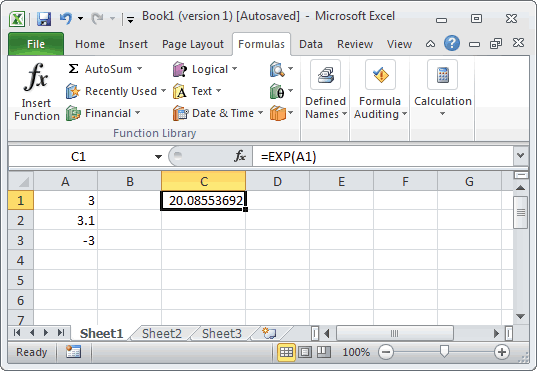

The position increases more rapidly as velocity increases, and eventually gains more slowly as the velocity begins to drop again. The inverse of EXP is the LN function, meaning that if you input a number into the the LN function and then nest that inside. All these functions are related by the ‘natural number’, e, equal to approximately 2.71828. You can see that when the velocity is near zero, the slope of the position curve is flat. The EXP function falls under the category of Math and Trigonometry Functions in Microsoft Excel, which includes LOG and LN. Right-click the velocity data and choose Format Data Series.

However, integrating an arbitrary continuous function in. The built-in library of mathematical functions cover many of the needs in day-to-day design task.

Excel Details: Integration in Excel using Gaussian Quadrature Microsoft Excel is a very powerful tool for a surprising range of applications. The velocity data are much smaller numbers than the position, so plot those on a secondary axis. Microsoft Excel Exponential Integral Functions. Select all three columns and insert a scatter chart. This will give you the same end position of 1600 feet, but it also gives all the position and velocity data points in between. Select this cell and double-click the fill handle to fill the formula down the column. However, the t2 argument will change as you go down the table, so you can simply click within cell B17 and leave that as a relative reference. You can begin the function:īoth of these arguments need to be made absolute references using F4 because they’ll be the same for every time point in the table. The initial position and the initial time are the same as above. For the position column, the arguments will be entered in a slightly different way. The worksheet already contains time and velocity data. Of course, the function can also be used to calculate the position at many different times. The Position function will give the result 1600 feet after 20 seconds. The first argument, x0, is the initial position in cell C5 t1 is the lower bound in cell C6, and t2 is the upper bound in cell C7. Type in the function name, then use Ctrl-Shift-A to automatically populate the names of the arguments. Remember this function needs three arguments passed to it: x0, t1 and t2. First, use it to calculate the position at 20 seconds. Now that the Position function is complete, you can use it in the spreadsheet to do calculations. Position = Position + (tb – ta)* (vel(ta) + vel(tb)) / 2 ‘sum the area under the curve for each slice ‘calculate areas using the trapezoidal rule All rights reserved.‘discretize the integral into “n” slices, “dt” wide The results are verified by deconvolution of test synthetic glow curves with F.O.M up to 0.0005%, experimental glow curve for CTD with F.O.M of 0.9781%, and in the case of GLOWCANIN project glow curves, the F.O.M is comparable to the least values achieved by inter-comparison participants.Īsymptotic approximation Computerized glow curve deconvolution (CGCD) Continuous energy distribution Discrete energy distribution Rational approximation Thermoluminescence (TL).Ĭopyright © 2021 Elsevier Ltd. A comparison of asymptotic and rational approximation to the built-in second order exponential integral function E 2(E/KT) for E/KT < 600 is also presented. The residual graph gives a clear visual understanding of the Figure of Merit (F.O.M). FOK, SOK, GOK, MOK, and Continuous Traps Distribution (CTD) with subtraction of optional background signal.

To obtain best values of trap parameters like activation energy (E), frequency factor (s), order of kinetics (b), GCD Analyzer has the capability of analyzing glow curve using selectable individual peak of various physical kinetic models i.e. This tool has a unique feature of TL glow curve analysis by combining discrete and continuous energy distributions for crystalline, amorphous, and mixed materials. It is capable of deconvolution of glow curves having discrete or continuous trap distribution and can be used for routine as well as emergency radiation dosimetric analysis. In this study an open-source tool GCD Analyzer, based on Microsoft® Excel, for Computerized Glow Curve Deconvolution analysis (CGCD) of thermoluminescence (TL) glow peak has been developed using a more accurate rational approximation.


 0 kommentar(er)
0 kommentar(er)
